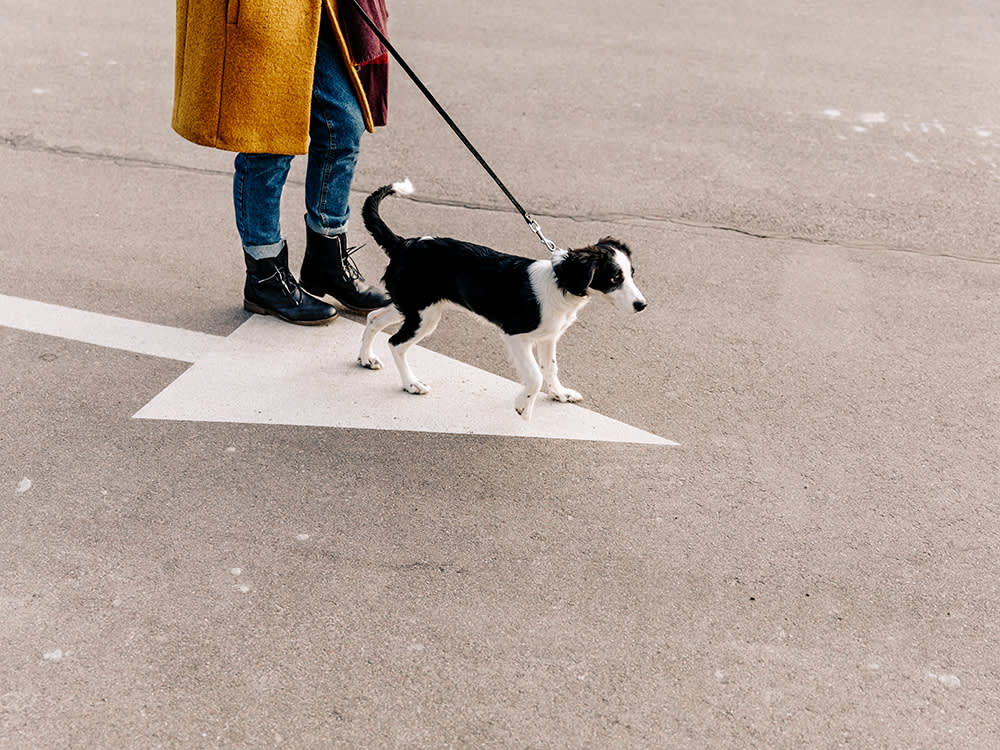Walk With Me: How to Leash Train a Puppy
Don’t let your new dog walk you.
Dogs go for walks on leashes. Simple, right? Except for one not-so-minor detail: you have to teach them how to do it. Though it may seem instinctual for some dogs, leash work is a learned skill that usually takes some serious pet parent patience. You’ll want to start early, because a bouncy puppy who pulls, chews, or jumps on strangers might be cute, but an unruly adult dog (yes, even the little ones) is a lot less charming.
We asked Lauren Novack, a dog behavior consultant at Behavior Vetsopens in new tab in NYC, how to prevent yourself from becoming that person being dragged down the street by their 100-pound Mastiff or tangled up in the leash of their five-pound Chihuahua. Here, her tips on how to get your puppy to walk calmly by your side and what gear to use to accomplish that.
The Basics of Leash Training a Puppy
If you’re feeling overwhelmed by all the to-dos of training a puppy, here’s the good news: “Puppyhood is an excellent opportunity for leash training since puppies tend to follow their owners around pretty closely already,” says Novack. “You can start as soon as you bring them home.” Leash training, by definition, just means teaching your dog to walk by your side and check in with you before sniffing out anything else in the environment. (That means no pulling or yanking!)
The main struggle with leash training is that you’ll be competing with a big, interesting world — filled with squirrels, street pizza, and still more squirrels — for your pet’s attention. “Keep training sessions short and remember to break for playtime,” says Novack. “Think: two-minute bursts of leash training, break for some play, then repeat for 15 minutes total.”
Wondering how long this whole process is gonna take? “Puppies are really easy and can probably be fully leash-trained in a month,” Novack says, but also cautions to be wary of the ‘teenage’ phase that dogs go through at around nine months old. “When they hit adolescence, they’re going to pretend they’ve never learned anything. Be ready to reinforce training and deal with some boundary pushing.”
The Leash-Training Gear You’ll Need
1. A harness over a collar, preferably
“While you can train a dog with just a collar, a harness is safer on their necks — especially growing puppies,” Novack recommends. If you ever notice your dog coughing while pulling on the leash, it’s a good idea to switch to a harness. But if your dog is easily distracted, a head haltie can correct that by literally turning their head toward you when you need them to focus.
2. A four- to six-foot leash
A four- to six-foot leash will give you the most control over your dog. “A retractable leash will teach your dog to pull,” says Novack. And when they pull, they go wherever they want (not what you want). Retractable leashes are also very dangerous, because a dog could dart out into traffic before you have a chance to reel them in.
3. Treats — small ones
“People give dogs treats that are way too big,” says Novack. “Treats should be the size of a pea.” You can even use kibble if your dog is excited by it, and essentially feed them their dinner throughout a training session without any additional calories. The point is: you don’t want them to have to stop to chew and delay the lesson.
The Top 3 Steps to Leash Train Your Puppy
Step 1: Start somewhere safe (and off-leash if possible)
In the ultimate irony, Novack recommends beginning leash training by letting your puppy off leash. “You don’t actually need a leash to teach your dog to pay attention to you and to walk by your side,” she says. Mind-blowing, we know. “The leash should be thought of more like a seatbelt than a primary tool — it’s there to keep your dog safe if an overwhelming stimulus makes them want to chase after it or run into traffic. Basically, the leash shouldn’t be the reason why your dog is by your side.”
But wait — don’t let your pup off leash just anywhere. Pick a location either indoors or in a fenced-in backyard (never anywhere unfenced — and no, invisible fences don’t count) where distractions are minimal. Now it’s time to teach them to walk next to you sans leash…
Step 2: Teach your puppy to stay right by your side
You do this by training your dog to think that next to your leg is the best place to be. Novack advises “building value” at that sweet spot by holding a treat there — right where your pup would be when you’re walking them. Without reaching out or prompting your puppy by touching your leg, let them come to the side of your leg to take it. Once you’ve mastered that, slowly take steps forward, treating your pet continuously as you walk, again making sure you’re doling out the treats right at your leg.
Once they comprehend that being by your side equals treats, stop holding the treat there the whole time. Instead, take a step forward and wait for your pup to follow suit before treating them. You can then take more and more steps forward — two, 10, and so on — before they get a treat. At some point in the process, layer in a leash so you can take them outside, challenging your pup to stay focused when there are distractions (squirrels) around.
Step 3: Relax the leash and let the real world be their reward
One you’ve got your pup sticking by your side without a steady flow of treats, it’s time to literally loosen the leash. You might come up with a verbal cue to let your dog know it’s okay to explore. Say there’s a pee spot they love to sniff — if they’re loosely by your side and look up to check in with you, you can say, “Okay, go sniff,” and they’ll know they have the green light to leave your side.
Just be sure not to start moving where they pull you. “What you want them to learn is that the fastest, easiest way to get what they want is by staying loosely by your side,” says Novack. “Pulling shouldn’t get them anywhere.”
Leash Training In Different Locations and Seasons
Some other factors to consider when leash training your puppy are location and season. While “leash training a dog uses the same basic tools wherever you are, people in the city often have to be way more on top of their training,” Novack says. “In a city as big as New York City, for example, a simple pee break could involve an untold number of distractions. Meanwhile, if you have a backyard in the suburbs, your dog may go on fewer walks and a less-than-perfect heel is no big deal.
“It’s important for dogs to be acclimated to all weather conditions,” adds Novack. “But if you live where there are extreme weather conditions for much of the year, a few extra pieces of gear may help.” A coat can help keep your dog warm in frigid temperatures, and booties will protect their paws from the salt that melts snow.” She also recommends treat tubesopens in new tab — squeeze tubes in flavors like peanut butter — which are easier to use when you’re wearing gloves.


